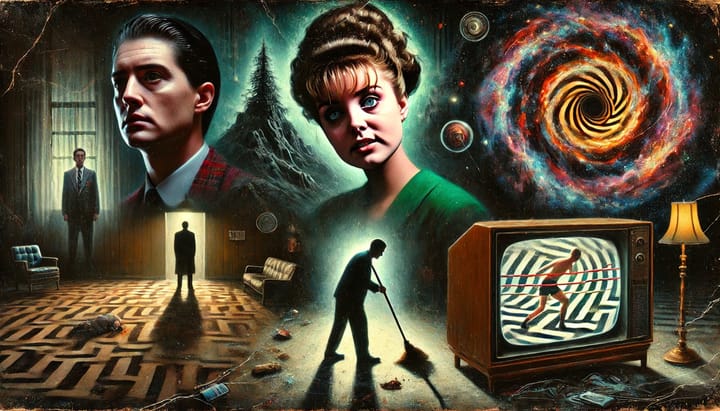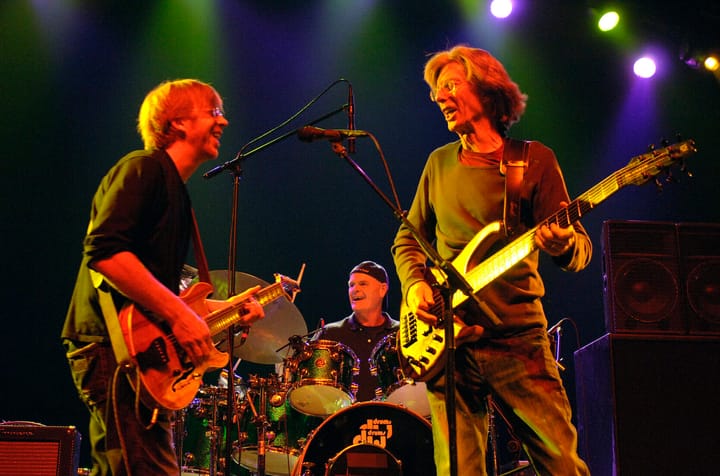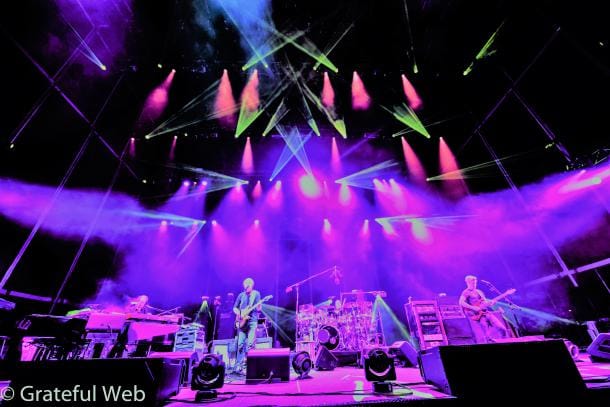Phish Review - Night two at Dick's Sporting Goods Park
The first set was anchored by a monumental Chalkdust Torture. This version reaffirmed the song's status as one of the band's premier jam vehicles in the modern era.
Night two at Dick's Sporting Goods Park showcased Phish at the height of their improvisational powers, delivering a show that will likely be remembered as one of the highlights of the 2024 summer tour.
The set was anchored by a monumental Chalkdust Torture. This version reaffirmed the song's status as one of the band's premier jam vehicles in the modern era. The improvisation was patient and exploratory, with Trey Anastasio and Page McConnell engaging in some particularly inspired interplay. Mike Gordon's bass work provided a solid foundation, allowing the jam to venture into uncharted territory while maintaining cohesion. The peak was nothing short of transcendent, with all four members locked in and pushing the energy to new heights.
Run Like an Antelope closed the first set in spectacular fashion. Jon Fishman's drumming was the driving force here, constantly pushing the band forward with ever-increasing intensity. There were several moments where it seemed the jam might spiral out of control, but the band's chemistry allowed them to dance on the edge of chaos without ever losing the thread. The tension-and-release dynamics were executed masterfully, resulting in a version that will likely be talked about for years to come.
The second set opened with a scorching Sand. Gordon's relentless bassline was the star here, providing a rock-solid groove for the rest of the band to build upon. Anastasio's guitar work was particularly fiery, with his solos reaching several blistering peaks. McConnell's keyboard contributions added depth and texture to the jam, pushing it into type II territory before seamlessly returning to the song's theme.
An Encore You Enjoy Myself proved to be one of the night's biggest highlights. The composed section was executed flawlessly, setting the stage for an extended improvisation. The vocal jam was particularly inspired, with the band using it as a launching pad to transition back into a full band jam. This innovative approach breathed new life into a Phish classic, demonstrating the band's continued willingness to push boundaries and explore new possibilities within their extensive catalog.
What's the Use? provided a moment of introspection amidst the high-energy improvisation. Its placement in the set was perfect, offering a chance for both the band and audience to catch their breath and reflect. The jam that emerged was deep and contemplative, with Anastasio's guitar lines weaving a haunting melody over Gordon's rumbling bass and McConnell's atmospheric keys.
The set closed with a mind-bending Steam. The jam built slowly but surely, with the band masterfully manipulating tension and release. Fishman's polyrhythmic drumming provided a complex foundation for the others to explore, resulting in some of the most adventurous playing of the night. The peak was nothing short of cathartic, sending the audience into a frenzy before gently easing back for a smooth landing.
Overall, this show demonstrated why Phish remains at the forefront of improvisational rock. Their ability to take familiar songs to new heights while still surprising listeners with unexpected twists is truly remarkable. If this performance is any indication, the band is operating at a level of creativity and cohesion that rivals any point in their storied career.
Long Version;
The second set opened with a monumental Chalk Dust Torture that immediately set the bar high for the rest of the night. From the moment the familiar opening riff rang out, it was clear that this version was destined for greatness. The composed section was executed with precision, Tr ey trey's vocals brimming with energy that set the stage for what was to come.
As the jam began, the band wasted no time diving into deep type II territory. Within minutes, they had left the song's typical structure far behind, venturing into a dark, atmospheric space that bore little resemblance to the upbeat rock of the original composition. Mike’s bass work was particularly noteworthy in these early stages, providing a rumbling foundation that anchored the explorations of his bandmates.
Page's synth work throughout the jam was nothing short of extraordinary. His choice of sounds evoked a distinctly sci-fi vibe, adding an otherworldly quality to the improvisation. There were moments when his synthesizer seemed to be in conversation with trey's guitar, the two instruments weaving in and out of each other to create a rich tapestry of sound.
Around the 10-minute mark, Jon Fishman's drumming became increasingly complex, his polyrhythms pushing the jam into even more experimental territory. This shift in rhythmic focus seemed to inspire trey, who responded with a series of effects-laden guitar lines that further enhanced the spacey atmosphere.
The band's communication throughout the jam was impeccable, with each member contributing ideas that were seamlessly incorporated into the collective sound. There were several points where the energy seemed to plateau, only for one of the musicians to introduce a new element that would propel the improvisation in an entirely new direction.
After nearly 20 minutes of this exploratory playing, just when it seemed the jam might dissolve into ambient territory, trey hit upon a major-key progression that signaled the beginning of the end. The band latched onto this idea immediately, building towards a blissful, euphoric climax. This transition from the dark, atmospheric improvisation to a more uplifting conclusion was handled masterfully, providing a perfect resolution to the intense journey that preceded it.
The final minutes of the jam saw trey unleashing a series of soaring guitar leads, backed by Page's swelling organ and Mike thunderous bass. Fishman's drumming became more straightforward but no less powerful, driving the band towards a peak that had the entire venue erupting in cheers.
This Chalk Dust Torture will likely be remembered as one of the standout versions of the year, if not the entire 3.0/4.0 era. Its seamless blend of dark exploration and triumphant resolution encapsulated everything that makes Phish's improvisational abilities so revered, setting an incredibly high bar for the rest of the show to follow.
Sand maintained the high energy established by Chalk Dust Torture, showcasing the band's ability to seamlessly transition between diverse improvisational spaces. The jam began with its characteristic funky groove, Mike Mike and Jon Fishman locking into a tight, driving rhythm. Trey trey's initial guitar work was restrained, focusing on rhythmic comping that added texture to the groove.
Around the 7-minute mark, the jam took an unexpected turn into a more subdued, lowkey segment. This section was particularly impressive, with each band member contributing intricate ideas without overpowering the others. Page Page's keyboard work stood out here, his choice of sounds adding an ethereal quality to the otherwise grounded groove.
Mike bass work during this quieter section was exceptional. His aggressive playing anchored the jam with thunderous low-end, providing a solid foundation for the others to explore. There were moments when his basslines seemed to be leading the improvisation, with the other members responding to his melodic ideas.
The band's mastery of dynamics was on full display as they built tension during these quieter sections. Fishman's subtle drum fills and cymbal work added layers of complexity, while trey's guitar gradually increased in intensity. The explosion back into the song's theme was perfectly timed, releasing the built-up energy in a cathartic burst that had the crowd erupting.
Ruby Waves emerged as the improvisational highlight of the second set. After a brief return to the song's theme, trey launched into a soaring solo that immediately signaled the band's intention to explore. For nearly 15 minutes, the quartet navigated through a wide range of sonic landscapes.
The early stages of the jam saw the band venturing into delicate, ambient territory. Page's piano work was particularly noteworthy here, his sparse, melodic lines creating a sense of space and anticipation. Mike and Fishman provided a subtle, almost jazzy backdrop, allowing trey and Page to engage in some beautiful interplay.
Around the 10-minute mark, the energy began to build. trey introduced a repeating guitar phrase that the band latched onto, gradually increasing in intensity. Mike bass work during this section was crucial, his melodic lines often leading the charge into new improvisational spaces.
The jam reached several distinct peaks, each one seemingly more powerful than the last. Fishman's drumming became increasingly dynamic, his fills driving the band to new heights. The final crescendo saw all four members firing on all cylinders, creating a wall of sound that was both beautifully melodic and intensely powerful.
The segue into What's the Use? was executed flawlessly, providing a moment of introspection after the intense Ruby Waves jam. The band's ability to shift gears so dramatically while maintaining a sense of flow speaks to their mastery of setlist construction.
As the show approached its conclusion, the opening notes of You Enjoy Myself rang out, signaling that something special was in store. This version will likely be remembered as one of the standout YEMs of recent years, showcasing the band's ability to breathe new life into even their most frequently played compositions.
The composed section was executed with surgical precision, each member navigating the complex changes with ease. trey's guitar work during the "pre-jam" segment was particularly sharp, his notes crisp and clear as he danced through the intricate melody. The trampoline section, often a playful interlude, seemed to energize the band, setting the stage for the improvisation to come.
The initial jam segment began in familiar territory, with Mike and Jon Fishman locking into the song's characteristic groove. McConnell's piano work in these early stages was notably fluid, his runs adding a jazzy flair to the proceedings. Around the 15-minute mark, trey began to push the boundaries, his playing becoming more experimental and effects-laden.
What truly elevated this YEM to special status was the unexpected "bonus" jam that followed the vocal segment. Instead of concluding the song as has become common in recent years, the band seamlessly transitioned back into a full-band improvisation. This additional section saw some of the night's most inspired playing, with all four members locked in and pushing each other to new heights.
trey's guitar work during this bonus jam was particularly notable. He alternated between soaring melodic lines that had the crowd roaring and more textural explorations that added depth and complexity to the sound. There was a moment around the 25-minute mark where his playing took on an almost synth-like quality, creating a wash of sound that the rest of the band built upon.
Mike's bass playing during this section was equally impressive. His lines became increasingly melodic and prominent, often taking the lead in steering the improvisation into new territories. Fishman's drumming was a study in dynamics, his ability to shift from subtle accents to thunderous fills driving the energy of the jam.
Page's contributions were crucial in creating the overall texture of the jam. His choice of sounds evolved throughout, moving from grand piano to organ to more experimental synth tones. There was a particularly magical moment near the end of the jam where his swirling, ethereal keyboard work created a bed of sound that seemed to inspire some of trey's most adventurous playing of the night.
As the jam wound down, the band skillfully brought the energy back to earth, creating a sense of resolution that felt both satisfying and slightly bittersweet. The final notes rang out to thunderous applause, the audience clearly aware that they had just witnessed something special.
In sum, this show demonstrated Phish's continued ability to surprise and delight, even within the context of songs they've played hundreds of times. The seamless flow between different musical moods, the depth of the improvisations, and the band's willingness to take risks and explore new territory all combined to create a memorable night of music. It served as a powerful reminder of why Phish remains one of the most compelling live acts in music, capable of creating transcendent moments that keep fans coming back night after night, year after year.




Comments ()